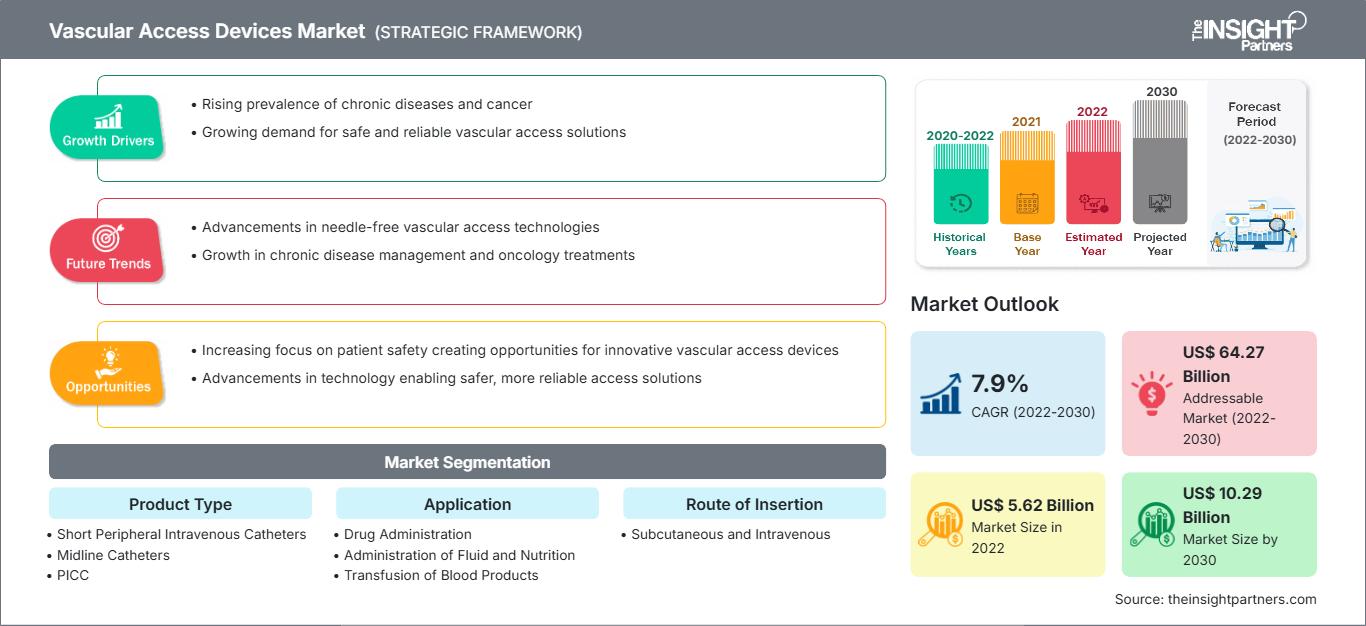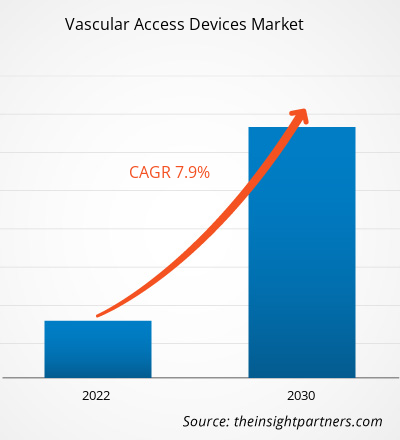[Forschungsbericht] Der Markt für Gefäßzugangssysteme wurde im Jahr 2022 auf 5,62 Milliarden US-Dollar geschätzt und soll bis 2030 voraussichtlich 10,29 Milliarden US-Dollar erreichen. Für den Zeitraum 2022–2030 wird eine durchschnittliche jährliche Wachstumsrate (CAGR) von 7,9 % erwartet.
Markteinblicke und Analystenmeinung:
Gefäßzugangssysteme werden an verschiedenen anatomischen Stellen platziert, um Zugang zur oberen oder unteren Hohlvene (Vena jugularis interna, Vena subclavia, Vena jugularis externa und Vena femoralis) zu erhalten. Das wachsende Marktvolumen für Gefäßzugangssysteme ist auf die zunehmende Verbreitung chronischer Erkrankungen und den steigenden Bedarf an Chemotherapien zurückzuführen. Strategische Initiativen von Unternehmen, um wettbewerbsfähig zu bleiben, fördern das Marktwachstum. Ein deutlicher Anstieg der Nutzung KI-gestützter robotergestützter Venenzugangsgeräte dürfte im Prognosezeitraum neue Markttrends für Gefäßzugangsgeräte mit sich bringen.
Wachstumstreiber und Herausforderungen:
Chemotherapie ist eine primäre oder adjuvante Behandlung, die durch die Verabreichung starker Medikamente zum Schrumpfen oder zur Beseitigung von Tumoren eingesetzt wird. Steigende Krebsfälle treiben daher die Nachfrage nach Chemotherapieverfahren an. Nach Schätzungen der Internationalen Agentur für Krebsforschung (IARC) wurden im Jahr 2020 weltweit 19,3 Millionen neue Krebsfälle gemeldet, und etwa 10 Millionen Menschen starben an der Krankheit. Laut dem Nationalen Krebsregister (NCR) wurden in Südafrika im Jahr 2020 rund 110.000 neue Krebsfälle diagnostiziert, und es gab über 56.000 krebsbedingte Todesfälle. Darüber hinaus wird die Krankheitslast in den kommenden Jahrzehnten voraussichtlich zunehmen. Bis 2030 und 2040 wird mit einem Anstieg der Zahl neuer Krebsfälle auf 138.000 bzw. 175.000 gerechnet, während die krebsbedingte Sterblichkeit in den genannten Jahren auf 73.000 bzw. 94.000 ansteigen wird. Die steigende Krebsprävalenz treibt somit das Wachstum des Marktes für Gefäßzugangssysteme voran.
Passen Sie diesen Bericht Ihren Anforderungen an
Sie erhalten kostenlos Anpassungen an jedem Bericht, einschließlich Teilen dieses Berichts oder einer Analyse auf Länderebene, eines Excel-Datenpakets sowie tolle Angebote und Rabatte für Start-ups und Universitäten.
Markt für Gefäßzugangsgeräte: Strategische Einblicke

- Holen Sie sich die wichtigsten Markttrends aus diesem Bericht.Dieses KOSTENLOSE Beispiel umfasst Datenanalysen, die von Markttrends bis hin zu Schätzungen und Prognosen reichen.
Sie erhalten kostenlos Anpassungen an jedem Bericht, einschließlich Teilen dieses Berichts oder einer Analyse auf Länderebene, eines Excel-Datenpakets sowie tolle Angebote und Rabatte für Start-ups und Universitäten.
Markt für Gefäßzugangsgeräte: Strategische Einblicke

- Holen Sie sich die wichtigsten Markttrends aus diesem Bericht.Dieses KOSTENLOSE Beispiel umfasst Datenanalysen, die von Markttrends bis hin zu Schätzungen und Prognosen reichen.
Berichtssegmentierung und -umfang:
Die Marktanalyse für Gefäßzugangssysteme wurde unter Berücksichtigung der folgenden Segmente durchgeführt: Produkttyp, Anwendung, Einführweg, Endverbraucher und Geografie. Der Markt ist nach Produkttyp in kurze periphere intravenöse Katheter, Midline-Katheter, PICC (peripher eingeführte zentrale Katheter), zentrale Katheter, implantierbare Ports und Zubehör segmentiert. Der Markt für das Segment der zentralen Katheter ist weiter segmentiert in CICC (zentral eingeführter zentraler Katheter), FICC (femoral eingeführter zentraler Katheter) und Sonstige. Basierend auf der Anwendung ist der Markt für Gefäßzugangssysteme in Arzneimittelverabreichung, Verabreichung von Flüssigkeit und Nahrung, Transfusion von Blutprodukten und Sonstige segmentiert. Basierend auf dem Einführweg ist der Markt in subkutan und intravenös unterteilt. Basierend auf den Endverbrauchern ist der Markt in Krankenhäuser und Kliniken, ambulante chirurgische Zentren und Sonstige segmentiert. Der Marktbericht für Gefäßzugangssysteme umfasst Nordamerika (USA, Kanada und Mexiko), Europa (Spanien, Großbritannien, Deutschland, Frankreich, Italien und das übrige Europa), den asiatisch-pazifischen Raum (Südkorea, China, Japan, Indien, Australien und den übrigen asiatisch-pazifischen Raum), den Nahen Osten und Afrika (Südafrika, Saudi-Arabien, die Vereinigten Arabischen Emirate und den übrigen Nahen Osten und Afrika) sowie Süd- und Mittelamerika (Brasilien, Argentinien und den übrigen Süd- und Mittelamerika).
Segmentanalyse:
Der Markt für Gefäßzugangssysteme ist nach Produkttyp in kurze periphere intravenöse Katheter, Midline-Katheter, PICC (peripher eingeführte zentrale Katheter), zentrale Katheter, implantierbare Ports und Zubehör unterteilt. Der Markt für das Segment der zentralen Katheter ist weiter unterteilt in CICC (zentral eingeführter zentraler Katheter), FICC (femoral eingeführter zentraler Katheter) und andere. Im Jahr 2022 hatte das Segment der kurzen peripheren intravenösen Katheter den größten Marktanteil bei Gefäßzugangsgeräten, und für dasselbe Segment wird zwischen 2022 und 2030 die höchste durchschnittliche jährliche Wachstumsrate erwartet.
Basierend auf der Anwendung ist der Markt für Gefäßzugangsgeräte in Arzneimittelverabreichung, Verabreichung von Flüssigkeit und Nahrung, Transfusion von Blutprodukten und Sonstiges unterteilt. Im Jahr 2022 hatte das Segment der Arzneimittelverabreichung den größten Anteil und wird voraussichtlich zwischen 2022 und 2030 die höchste durchschnittliche jährliche Wachstumsrate verzeichnen.
Basierend auf der Einführmethode ist der Markt für Gefäßzugangsgeräte in subkutane und intravenöse Geräte unterteilt. Das intravenöse Segment hatte 2022 einen größeren Marktanteil und wird zwischen 2022 und 2030 voraussichtlich eine höhere durchschnittliche jährliche Wachstumsrate verzeichnen.
Nach Endverbraucher ist der Markt in Krankenhäuser und Kliniken, ambulante chirurgische Zentren und Sonstiges unterteilt. Der Markt für Gefäßzugangssysteme im Krankenhaus- und Kliniksegment wird zwischen 2022 und 2030 voraussichtlich wachsen.
Regionale Analyse:
Nordamerika trägt am stärksten zum globalen Marktwachstum bei. Der asiatisch-pazifische Raum wird voraussichtlich zwischen 2022 und 2030 die höchste durchschnittliche jährliche Wachstumsrate (CAGR) verzeichnen. Nordamerika hatte 2022 den größten Anteil am Weltmarkt, was auf die zunehmende Verbreitung chronischer Erkrankungen, die Zunahme geriatrischer Bevölkerungsgruppen, die Präsenz wichtiger Marktteilnehmer bei der Entwicklung neuer und bestehender Produkte sowie den zunehmenden technologischen Fortschritt zurückzuführen ist. In Nordamerika hatten die USA 2022 den größten Marktanteil.
GefäßzugangssystemeRegionale Einblicke in den Markt für Gefäßzugangsgeräte
Die Analysten von The Insight Partners haben die regionalen Trends und Faktoren, die den Markt für Gefäßzugangsgeräte im Prognosezeitraum beeinflussen, ausführlich erläutert. In diesem Abschnitt werden auch die Marktsegmente und die geografische Lage in Nordamerika, Europa, dem asiatisch-pazifischen Raum, dem Nahen Osten und Afrika sowie Süd- und Mittelamerika erörtert.
Umfang des Marktberichts zu Gefäßzugangsgeräten
| Berichtsattribut | Einzelheiten |
|---|---|
| Marktgröße in 2022 | US$ 5.62 Billion |
| Marktgröße nach 2030 | US$ 10.29 Billion |
| Globale CAGR (2022 - 2030) | 7.9% |
| Historische Daten | 2020-2022 |
| Prognosezeitraum | 2022-2030 |
| Abgedeckte Segmente |
By Produkttyp
|
| Abgedeckte Regionen und Länder | Nordamerika
|
| Marktführer und wichtige Unternehmensprofile |
|
Dichte der Marktteilnehmer für Gefäßzugangsgeräte: Verständnis ihrer Auswirkungen auf die Geschäftsdynamik
Der Markt für Gefäßzugangsgeräte wächst rasant. Die steigende Nachfrage der Endverbraucher ist auf Faktoren wie veränderte Verbraucherpräferenzen, technologische Fortschritte und ein stärkeres Bewusstsein für die Produktvorteile zurückzuführen. Mit der steigenden Nachfrage erweitern Unternehmen ihr Angebot, entwickeln Innovationen, um den Bedürfnissen der Verbraucher gerecht zu werden, und nutzen neue Trends, was das Marktwachstum weiter ankurbelt.

- Holen Sie sich die Markt für Gefäßzugangsgeräte Übersicht der wichtigsten Akteure
Branchenentwicklungen und Zukunftschancen:
Die Marktprognose für Gefäßzugangsgeräte basiert auf verschiedenen sekundären und primären Forschungsergebnissen wie wichtigen Unternehmenspublikationen, Verbandsdaten und Datenbanken. Laut den Pressemitteilungen der wichtigsten Marktteilnehmer sind nachfolgend einige Strategien aufgeführt:
- Im November 2023 brachte BD (Becton, Dickinson and Company) eine neue nadelfreie Blutentnahmetechnologie auf den Markt, die mit integrierten Kathetern kompatibel ist und dazu beiträgt, die Vision des Unternehmens von einem „One-Stick-Krankenhausaufenthalt“ zu verwirklichen. Das nadelfreie Blutentnahmegerät PIVO Pro verfügt über Designverbesserungen, um Kompatibilität mit integrierten und langen peripheren IV-Kathetern zu erreichen, darunter das neue geschlossene IV-Kathetersystem Nexiva mit NearPort IV-Zugang.
- Im Mai 2023 brachte Teleflex Inc. zwei neue Geräte auf den Markt – das Arrow VPS Rhythm DLX-Gerät und das NaviCurve Stylet –, die das Einführen des PICC verbessern und das Komplikationsrisiko verringern sollen. Das VPS Rhythm DLX-Gerät liefert Echtzeitinformationen zur Position der Katheterspitze anhand der elektrischen Herzaktivität des Patienten. Der NaviCurve-Stilett verfügt über eine anatomische Krümmung und eine flexible Spitze, die sich automatisch an die Anatomie des Patienten anpasst und so das Vorschieben des PICC in die obere Hohlvene (SVC) für eine erfolgreiche Insertion erleichtert.
Wettbewerbslandschaft und wichtige Unternehmen:
Teleflex Inc, BD, B. Braun SE, Terumo Medical Corporation, Medtronic, Fresenius Kabi, Baxter, Vygon SAS, Kimal und Access Vascular Inc gehören zu den führenden Akteuren, die im Marktbericht für Gefäßzugangsgeräte vorgestellt werden. Darüber hinaus wurden im Rahmen der Studie mehrere weitere Akteure untersucht und analysiert, um einen ganzheitlichen Überblick über den Markt und sein Ökosystem zu erhalten. Diese Unternehmen konzentrieren sich auf geografische Expansionen und die Einführung neuer Produkte, um die wachsende Nachfrage von Verbrauchern weltweit zu erfüllen und ihr Produktangebot in Spezialportfolios zu erweitern. Ihre globale Präsenz ermöglicht es ihnen, einen großen Kundenstamm zu bedienen und so die Marktexpansion zu erleichtern.
- Historische Analyse (2 Jahre), Basisjahr, Prognose (7 Jahre) mit CAGR
- PEST- und SWOT-Analyse
- Marktgröße Wert/Volumen – Global, Regional, Land
- Branchen- und Wettbewerbslandschaft
- Excel-Datensatz
Aktuelle Berichte
Erfahrungsberichte
Grund zum Kauf
- Fundierte Entscheidungsfindung
- Marktdynamik verstehen
- Wettbewerbsanalyse
- Kundeneinblicke
- Marktprognosen
- Risikominimierung
- Strategische Planung
- Investitionsbegründung
- Identifizierung neuer Märkte
- Verbesserung von Marketingstrategien
- Steigerung der Betriebseffizienz
- Anpassung an regulatorische Trends






















 Kostenlose Probe anfordern für - Markt für Gefäßzugangsgeräte
Kostenlose Probe anfordern für - Markt für Gefäßzugangsgeräte